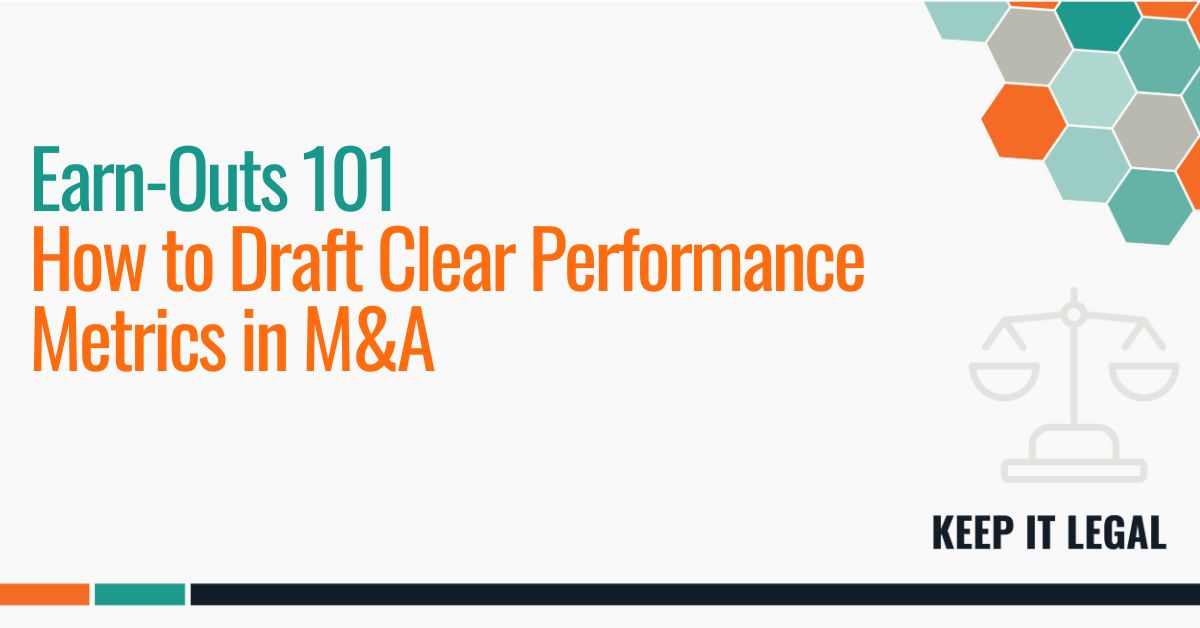The earn-out, which ties part of the purchase price to the post-closing performance of the acquired company, can bridge a valuation gap and get a deal across the finish line. Unfortunately, it is also one of the clauses most likely to trigger post-closing litigation. When targets miss metrics, everyone grabs a lawyer instead of a calculator.
The roadmap below shows how to keep your earn-out on track. It includes practical drafting tips, a model schedule, and a concise dispute-resolution clause that can slot directly into your Purchase and Sale Agreement.
1. Why Earn-Outs Blow Up
Earn-out fights usually spring from five avoidable drafting problems. First, fuzzy financial metrics such as referencing EBITDA without embedding the exact formula allow buyers to reclassify expenses and modify the target numbers. Second, mid-stream accounting changes like switching from cash to accrual can make revenue appear to shrink if the Agreement does not freeze accounting policies. Third, operating-control conflicts occur when the buyer cuts marketing or shutters sales channels; sellers then claim the buyer failed to use commercially reasonable efforts to achieve the targets. Fourth, moving targets such as basing payments on industry revenue without naming a published index leave both sides guessing what benchmark applies. Finally, weak audit-access language lets buyers restrict the seller’s review of financials, pushing the dispute straight to court.
All five pitfalls are preventable with tight definitions, fixed accounting methods, clear operational effort clauses, precise benchmarks, and explicit information rights. The next section explains how.
2. Drafting Metrics Everyone Understands
- Define the yardstick
Decide whether the trigger is revenue, EBITDA, gross profit, user count, or something else. Write the formula into the Agreement, for example, “Net revenue in accordance with U.S. GAAP, consistent with Seller’s audited 2024 policies in Exhibit B.” If you must use a non-GAAP figure, attach a sample worksheet. - Freeze the accounting
Require the buyer to apply the same accounting policies used in the last full fiscal year before closing unless the seller consents in writing. - Cap discretion without capping growth
Include a commercially reasonable efforts promise that the buyer will not take actions primarily to avoid the earn-out but still allow ordinary course decisions. - Deliver the data
Give the seller monthly or quarterly financial packages plus reasonable access to underlying records, not just a single statement on payout day. - Add a true-up mechanism
Either party may trigger a neutral accountant review within thirty days of receiving the earn-out statement; the accountant’s conclusion is final and binding absent fraud. - Cap the clock
Set a clear deadline, often three years or less. Disputes tend to rise sharply after year three, when memories fade and strategies shift.
3. Sample Earn-Out Schedule

Key terms:
- Measurement: Revenue and EBITDA calculated under U.S. GAAP, using the accounting policies found elsewhere in document.
- Payment timing: Within thirty days after delivery of the audited financials for the applicable year.
- Catch-up: If year 1 falls short but the cumulative year 1-2 targets are met, the unpaid year 1 amount is paid with year 2.
4. Model Dispute-Resolution Clause
Any disagreement arising from the calculation of Revenue, EBITDA, or an Earn-Out Payment shall be submitted within thirty days to an independent accounting firm of international standing chosen jointly by Buyer and Seller (the “Arb-Accountant”). The Arb-Accountant shall act as an expert, not an arbitrator, and shall resolve only the disputed items in accordance with the principles set forth in this Agreement. Its determination is final and binding. Fees are split fifty-fifty unless the Arb-Accountant finds that a party’s position was frivolous, in which case that party bears all fees.
Why this works:
- Speed. A CPA can settle math disputes in weeks, not years.
- Expertise. Accounting experts focus on GAAP calculations, not legal posturing.
- Limited scope. The fight stays confined to numbers, not the entire Agreement.
5. Quick-Reference Checklist
- Name the metric, define the formula, freeze accounting policies.
- Align incentives so the buyer can run the business within agreed guardrails.
- Require data sharing through regular reports plus audit rights.
- Plan for disagreement with a pre-agreed accountant review.
- Document everything from board resolutions to the integration plan and earn-out schedule.
Clear drafting turns an earn-out from future litigation fuel into a genuine win-win. The seller captures upside they helped create, and the buyer only pays for proven performance. Lock down definitions, data rights, and a fast dispute path now so everyone can focus on growing the business later.
If you have questions about your business purchase or sale, please feel free to contact me.


